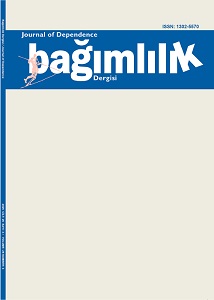SYNTHETİC CANNABİNOİD RECEPTOR AGONİSTS (SCRAS) INDUCED SEİZURE: A CASE REPORT
Keywords:
Synthetic cannabinoid receptor agonist, cannabis, seizureAbstract
With an ever-increasing prevalence, exposing new challenges to healthcare personnel, the use of synthetic cannabinoid receptor agonists (SCRAs) affects many systems. Clinical manifestations that may be caused by it become more predictable day by day thanks to increasing number of case reports on this issue. The use of these substances gives rise to serious side effects, which in turn affect psychiatric, neurological, cardiovascular, renal and pulmonary systems. Recently, there are a growing number of reports indicating that SCRAs would lead to seizures. It is considered that notably the patients referred to emergency rooms due to SCRA induced toxicity may be experiencing a series of life-threatening clinical presentations, one of which would probably be seizure, and which may sometimes require intensive care followup. This shows that all clinicians and the society should be highly aware of and get prepared for potential hazards to be triggered by use of SCRAs. This report makes mention of a case where a patient without any record of seizure in his medical history, who experienced his first epileptic seizure following SCRAs induced intoxication, and where the seizure was hardly terminated.
References
Seely KA, Lapoint J, Moran JH, Fattore L. Spice drugs are more than harmless herbal blends: A review of the pharmacology and toxicology of synthetic cannabinoids. Prog Neuro-Psychop-harmacol Biol Psychiatry 2012; 39: 234-243.
Hermanns-Clausen M, Kneisel S, Szabo B, Auwarter V. Acute toxicity due to the confirmed consumption of synthetic cannabinoids: Clinical and laboratory findings. Addiction 2013; 108: 534-544.
Bozkurt M. Sentetik kannabinoidler: Artık herkesin sorunu. Update in Psychiatry, Journal of Psychiatric Association of Turkey for Continuing Education/Continuing Professional Development 2014; 4: 165-177.
Brewer TL, Collins M. A review of clinical manifestations in adolescent and young adults after use of synthetic cannabinoids. JSPN 2014; 19: 119-126.
Gugelmann H, Gerona R, Li C, et al. ‘Crazy Monkey’ poisons man and dog: Human and canine seizures due to PB-22, a novel synthetic cannabinoid. Clin Toxicol (Phila) 2014; 52: 635-638.
Tait RJ, Caldicott D, Mountain D, et al. A systematic review of adverse events arising from the use of synthetic cannabinoids and their associated treatment. Clin Toxicol (Phila) 2016; 54: 1-13.
Louh IK, Freeman WD. A ‘spicy’ encephalopathy: Synthetic cannabinoids as cause of encephalopathy and seizure. Crit Care. 2014; 18: 553.
Wells DL, Ott CA. The “new” marijuana. Ann Pharmacother. 2011; 45: 414-417.
Pants S, Deshmukh A, Dholaria B, et al. Spicy seizure. AJMS 2012; 344: 67-68.
Tofighi B, Lee JD. Internet highs-seizure saftercon-sumption of synthetic cannabinoids purchased online. Journal Addic Med. 2012; 6: 240-241.
de Havenon A, Chin B, Thomas KC, Afra P. The secret “spice”: An undetectable toxic cause of seizure. Neurohospitalist 2011; 1: 182-186.
Harris CR, Brown A. Synthetic cannabinoid intoxication: a case series and review. J Emerg Med 2013; 44: 360-366.
Schneir AB, Baumbacher T. Convulsions associated with the use of a synthetic cannabinoid product. J Med Toxicol. 2012; 8: 62-64.
Hoyte CO, Jacob J, Monte AA, et al. A characterization of synthetic cannabinoid exposures reported to the National Poison Data System in 2010. Ann Emerg Med 2012; 60: 435-438.
McQuade D, Hudson S, Dargan PI, Wood DM. First Eoropean case of convulsions related to analytically confirmed use of the synthetic cannabinoid receptor agonist AM-2201. Eur J Clin Pharmacol 2013; 69: 373-376.
Lapoint J, James LP, Moran CL, et al. Severe toxicity following synthetic cannabinoid ingestion. Clin Toxicol (Phila) 2011; 49: 760-764.
Sampson CS, Bedy SM, Carlisle T . Withdrawal seizures seen in the setting of synthetic cannabinoid abuse. Am J Emerg Med 2015; 33: 1712.
Schep LJ, Slaughter RJ, Hudson S, et al. Delayed seizure-like activity following analytically confirmed use of previously nreported synthetic cannabinoid analogues. HET 2015; 34: 557-560.
Sheikh IA, Lukšič M, Ferstenberg R, Culpepper-Morgan JA. Spice/K2 synthetic marijuana-induced toxic hepatitis treated with N-acetyl-cysteine. Am J Case Rep 2014; 15: 584-588.
Altinisik U, Altinisik HB, Simsek T, Simsek E. Clinical characteristics of patients diagnosed with synthetic cannabinoid (Bonsai) intoxication in intensive care unit. J Turk Soc Intens Care 2015; 13: 117-121.
Sarıkaya M, Taser N. Bonzai kullanımına bağlı toksik hepatit. EP-17.5. Hepatoloji Okulu; Kocaeli, 2014.
Simmons J, Cookman L, Kang C, Skinner C. Three cases of “Spice” exposure. Clinical Toxicol (Phila) 2011; 49: 431-433.
Downloads
Published
How to Cite
Issue
Section
License
Copyright (c) 2025 Journal of Dependence

This work is licensed under a Creative Commons Attribution-NonCommercial-NoDerivatives 4.0 International License.
...
